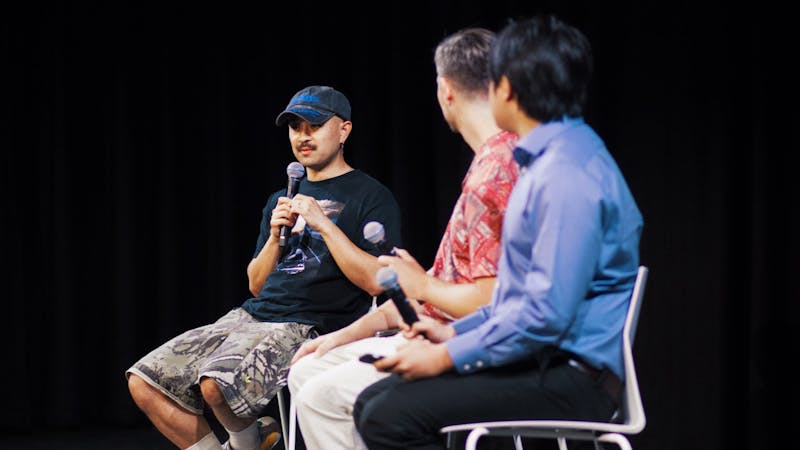Eclectic and unconventional
This month, the Rice Media Center has been taken over by an eclectic blend of film and sculpture. The exhibition, open until April 4, includes a living structure composed of over 100 rectangular jars, two perspective-altering short films and even a 6-foot-tall phallic wine decanter, among other things.
This is Tetramorph, an exhibition of art and film created by the four recipients of the Mavis C. Pitman Fellowship. Every year, visual arts majors can compete to receive funds, typically around $1,500, from the prestigious Pitman Endowment to help them construct their dream project. Typically, three or four students are chosen to create a project, install it and host a reception to kick off the exhibition. This year's winners are Hanszen College senior Trey Ferguson, Sid Richardson College senior Jessie Anderson, Duncan College senior Lisa Biletska and Lovett College senior Alex Fernandez. The Thresher sat down with a few of the artists to talk about their pieces, the Pitman, and the challenges of making and installing such complex, unconventional work.
Jessie Anderson
Anderson's piece, a commentary on the nature of advertising, includes three sculptures of varying complexity. The first consists of two silver tote bags reconstructed into shoes, labeled fittingly on the side with the phrase, "I'm a shoe lover." The second sculpture is a giant bin filled with pastel-dyed socks on top and various bits of detritus on the bottom, including broken bottles and wire. Video game printouts decorate the sides, along with the phrase, "Choose from a smashing assortment of socks and belts." Finally, a green decanter, positioned to resemble a king cobra, sits in the middle of the exhibit, surrounded by text extracted from a sexualized wine decanter advertisement campaign.
Anderson said her piece is intended to encourage a philosophical evaluation of marketing.
"I've been looking at these advertisements and thinking about the way that when you're representing an object to someone who has no physical realization of it - can't see it, touch it, feel it - the text that you produce to enliven the object ends up trying to describe the consumer, as opposed to the object itself," Anderson said. "All of these really appealing or exaggerative or hyperbolic descriptions of the object are really meant to bring in a certain type of person. So if the text of these tote bags is 'I am a shoe lover,' what am I really trying to say? What is that person in being a shoe lover? What object are they referencing?"
Anderson said the process of creating the work was rather arduous. She said she spent her entire spring break in her studio, as well as most of the days afterwards. For her, the most time-consuming part was traveling around to numerous stores all over Houston to purchase miscellaneous items ranging from headphones to socks, usually to find that the large quantity she needed was not in stock.
"My experience, and I'm fairly sure the experience of all of the other award winners, was that this was a very time- and energy-consuming experience," Anderson said. "I think that, in a way, it became the funnel for the first half of my semester; all of my attention went this way, and I was really passionate about working at it."
Anderson said a few complications arose as she tried to finish her piece.
"When you see the decanter, you can see how ridiculous it is to imagine putting that into the back of my friend's car and having it in his driver's seat and just hoping we don't get pulled over because I have no way to explain the 6-foot-tall lime green penis, which you know ... also has enough chicken wire to scratch you raw," Anderson said.
She said the work was unique in that while the creative element proved fairly straightforward, she encountered numerous mundane complications that proved frustrating. Howev
er, she said that in the end, unveiling the exhibit was very meaningful in that she was able to share her piece with an audience.
"There's just so many down-to-earth, physical problems that I'd never encountered before," Anderson said. "But I kind of enjoy that frenzied moment of everything coming together. I hadn't slept very much, but what I had was immediate gratification because all of this effort was flooded with people, and I could talk to them about it. I don't necessarily remember a lot of what I said, but I got to see people interacting with my sculpture. It was really exciting and really rewarding."
Trey Ferguson
Ferguson, a film major, said he was inspired by Renee Falconetti's legendary performance in the 1928 film The Passion of Joan of Arc.
"When I watched it, I was really drawn to the actress's face, just the way it was photographed. There were a lot of close ups [and] she wasn't wearing makeup," Ferguson said. "Her expressions were so vivid."
Ferguson said he re-edited the film, blacking out everything except for Falconetti's face. He then built a structure that inverted the way the picture would be perceived. Instead of looking from the source of light to the film, with Ferguson's structure, the viewer looks directly at the light. Ferguson said he also minimized the distance between the onlooker and the image, creating a different experience than watching a movie screen.
"It seems like she goes through the entire range of human emotion - everything from detachment to distress," Ferguson said. "And I wanted to show all these displays of emotion. In a way, facial expressions are like a language of their own. By removing it from the narrative context, I felt like I was still able to keep the impact those images had but at the same time give them an indexical quality, where it was about the language that expresses emotions."
Ferguson said creating the work was a slow, technical process.
"I had to go through the entire film," Ferguson said. "Every shift, every face. [I] had to completely change everything. [I had to] black out the screen - I had nightmares about that face."
Ferguson said working so closely with other artists presented an unusual challenge. The four Pitman fellows had to not only perfect their own work, but also work together to create the advertising and branding for the exhibition.
"It's a little weird when you're working with other artists. We had to design all the postcards together and come up with a title, which was a challenge since our work is so different. We didn't want to force a theme .... [We chose Tetramorph] because we wanted to convey the idea of four separate parts coming into something completely different. It was [Anderson's] idea, and I'm really happy with it."
Alex Fernandez
Fernandez, who is also majoring in philosophy and enjoys gardening, said she wanted her piece to reflect her multiple interests. Her work, which sits next to a window, is comprised of dozens of jars containing spindly plants, stacked on risers in a sprawling design. Posted next to them, above a table with squirt bottles, reads the sign "NOTICE: In Order For This Living ArtScape To Survive, You (The Viewer) Must Care For It." An instructive poster explains that viewers are expected to use the squirt bottles to water the plants and record that they did so in a log lying next to the exhibit. Fernandez said she wants people to take the plants home when the exhibit leaves; they can sign up to do so at the exhibit.
Fernandez said she was interested in the philosophical question of contracts and how they can be thought of in regard to art.
"My question was ... when a viewer comes into a space, what are the responsibilities of the viewer, and what are the responsibilities of the artist?" Fernandez said. "In most cases, the artist simply puts something out, and the viewer can choose whether to engage in it. So I thought I would take it one step farther and ask what would happen if the viewer had to take on some responsibility? What would that mean for an artist to write a contract for a viewer, for them to sign and take over?"
Fernandez said the practical elements of constructing her project were more difficult than expected. While she said she was surprised to find that she could order 336 jars in bulk, getting them to the space presented some issues.
"The company sent me an email asking me if I had access to a forklift. Apparently, there were just so many and they were so heavy, the [shippers] doubted they'd be able to get them off the truck," Fernandez said.
While Fernandez was ultimately able to unload the jars, Fernandez said she also had to figure out how to plant dozens of indoor plants. She ended up deciding to use air plants, which only require air and water to survive. She said she thinks the lack of soil is also more aesthetically pleasing.
Fernandez said the Pitman Fellowship provided her with an extraordinary opportunity that is often not available to art majors.
"As a studio major, you have to fund all your own works, and that clearly confines what you're able to make," Fernandez said. "So that's why, going into this, your professors tell you to think big and think of something you wouldn't be able to do otherwise. I've always been really interested in sculpture, living plants and incorporating new mediums, and so I knew this would be an awesome opportunity to do what I've always wanted to do. It was truly an amazing experience."
See the works yourself at , on display at the Rice Media Center Monday through Friday until April 4.
More from The Rice Thresher

Worth the wait: Andrew Thomas Huang practices patience
Andrew Thomas Huang says that patience is essential to being an artist. His proof? A film that has spent a decade in production, a career shaped by years in the music industry and a lifelong commitment to exploring queer identity and environmental themes — the kinds of stories, he said, that take time to tell right.

Andrew Thomas Huang puts visuals and identity to song
Houston is welcoming the Grammy-nominated figure behind the music videos of Björk and FKA twigs on June 27.

Live it up this summer with these Houston shows
Staying in Houston this summer and wondering how to make the most of your time? Fortunately, you're in luck, there's no shortage of amazing shows and performances happening around the city. From live music to ballet and everything in between, here are some events coming up this month and next!

Please note All comments are eligible for publication by The Rice Thresher.